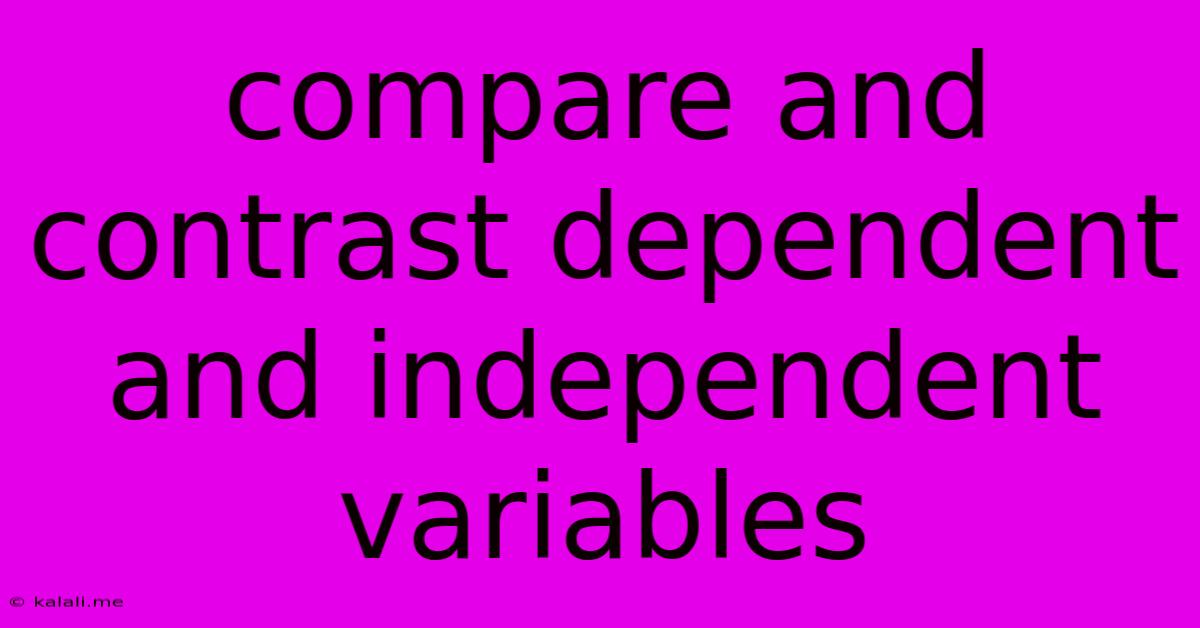Compare And Contrast Dependent And Independent Variables
Kalali
Jun 15, 2025 · 3 min read

Table of Contents
Dependent vs. Independent Variables: A Comprehensive Comparison
Understanding the difference between dependent and independent variables is fundamental to conducting any meaningful research or experiment. This article will delve into the core concepts of each, highlighting their key distinctions and providing practical examples to solidify your understanding. Whether you're a seasoned researcher or just beginning your journey into data analysis, mastering this concept is crucial for interpreting results accurately and designing effective studies.
What is an Independent Variable?
An independent variable is the variable that is manipulated or changed by the researcher to observe its effect on the dependent variable. It's the cause in a cause-and-effect relationship. Think of it as the variable you have control over. It's often the variable that's being tested or experimented on. The researcher selects specific values or levels of the independent variable to see how these changes affect the outcome.
Examples of Independent Variables:
- In a study on the effect of fertilizer on plant growth: The amount of fertilizer applied is the independent variable.
- In an experiment testing the effect of sleep deprivation on reaction time: The amount of sleep deprivation (e.g., 4 hours, 6 hours, 8 hours) is the independent variable.
- In research exploring the impact of different teaching methods on student performance: The teaching method employed is the independent variable.
What is a Dependent Variable?
A dependent variable is the variable that is measured or observed. It's the effect in a cause-and-effect relationship. It's the variable that is expected to change in response to the manipulation of the independent variable. The researcher measures how the dependent variable changes based on the different levels of the independent variable. It's dependent on the independent variable.
Examples of Dependent Variables:
- In a study on the effect of fertilizer on plant growth: The height of the plants is the dependent variable.
- In an experiment testing the effect of sleep deprivation on reaction time: The reaction time of participants is the dependent variable.
- In research exploring the impact of different teaching methods on student performance: The student's test scores are the dependent variable.
Key Differences Summarized:
| Feature | Independent Variable | Dependent Variable |
|---|---|---|
| Definition | Manipulated or changed by the researcher | Measured or observed by the researcher |
| Role | The cause | The effect |
| Control | Controlled by the researcher | Not controlled directly by the researcher |
| Measurement | Not measured directly; its values are chosen | Measured to observe the effect of the independent variable |
Comparing and Contrasting: A Deeper Look
The relationship between independent and dependent variables is fundamentally about cause and effect. The independent variable is the presumed cause, and the dependent variable is the presumed effect. However, correlation does not equal causation. Just because two variables are related doesn't necessarily mean one directly causes the other. Other factors, known as confounding variables, can influence the results. A well-designed experiment aims to minimize the influence of confounding variables.
Furthermore, it's crucial to note that there can be multiple independent variables influencing a single dependent variable in a study. Similarly, a single independent variable can influence multiple dependent variables simultaneously. Understanding these complex relationships requires careful consideration of the research question and experimental design.
Conclusion:
Distinguishing between independent and dependent variables is a cornerstone of scientific research and data analysis. By understanding their roles and the relationship between them, you can better interpret research findings, design robust experiments, and draw meaningful conclusions from your data. Always carefully consider the cause-and-effect relationship and potential confounding variables to ensure your analysis is accurate and reliable.
Latest Posts
Latest Posts
-
Identify The True And False Statements About Survey Research
Jun 15, 2025
-
Chromosomes Are Primarily Composed Of Dna And
Jun 15, 2025
-
What Are All Of The Factors Of 56
Jun 15, 2025
-
Which Of The Following Is A Characteristic
Jun 15, 2025
-
What Are All The Factors For 56
Jun 15, 2025
Related Post
Thank you for visiting our website which covers about Compare And Contrast Dependent And Independent Variables . We hope the information provided has been useful to you. Feel free to contact us if you have any questions or need further assistance. See you next time and don't miss to bookmark.